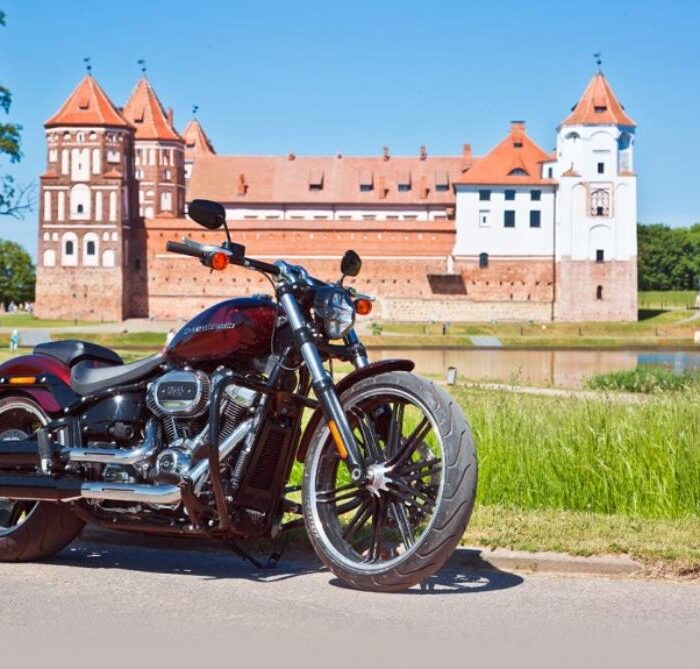No, this isn’t the infamous car from the popular movie known by the feminine name “Christine.” That car was a model from a year later, dressed up more luxuriously, and entirely a product of fiction. Stephen King, the author behind the novel that inspired the film, wasn’t deeply knowledgeable about cars. He penned his book beginning in the middle, adding the start, the end, and many details only later, which resulted in a vehicle that was more fantastical than real. But the resemblance is there…
1957 Plymouth Savoy KP-31-2 Sport Coupe
“You resemble her, like a sister, But, of course, you are not her—unfortunately.” — Maxim Leonidov
Stephen King revealed in an interview that he was searching for a car with a striking appearance for the main character of his first “automotive” novel, one that hadn’t yet achieved “cult” status among American readers. For this reason, he dismissed a 1957 Chevrolet as “too legendary.” Instead, he chose the Plymouth Fury, largely due to its apt name, which perfectly matched the malevolent beauty he envisioned.

The 1957 model is easily recognizable by its headlights of different diameters and vertical slots below the bumper. Less obvious is the vertical decorative element in the center of the faux radiator grille—a highly stylized image of the sails of the Mayflower, the ship of the American Pilgrims—but it too is a characteristic feature of the 1957 Plymouth vehicles.
King might have picked the right car and, in doing so, inadvertently elevated it to cult status, especially following the film’s release. However, the Plymouth Fury as described in his novel did not and could not exist in reality. Notably, in 1957 and 1958, the Fury model was available only as a two-door, the priciest in its series, and solely in light beige. This is pertinent considering the “Red Autumn” body color frequently mentioned in the novel and shown in the film. Of course, any dissatisfied owner could repaint their car, but in the movie, the vehicle is depicted on the assembly line sporting a red-and-white scheme. To create this incorrect portrayal, filmmakers built a massive assembly line set within an abandoned furniture factory because filming at the Chrysler plant was not an option, and the equipment had long been modernized—the film was shot in 1983, after all.



The front bench seat is spacious and comfortable, but offers no lateral support (and where would it come from?). There are too many gauges on the dashboard to compare with “cat’s eyes.” The button-operated transmission selector to the left of the steering wheel lacks a “Park” position.
Our illustrations feature not the top-tier Fury but the more economical Savoy, which was available in a red-and-white color scheme in 1957, not 1958, as indicated by several specific front-end design elements. For the cover of his first book’s edition, King posed next to such a car, even though the narrative discussed a completely different vehicle!
“Well, ‘you resemble her, like a sister’—it’s easy to mix them up…” However, as the author continues his description of the “car with a bad character,” he piles on absurdities, demonstrating his lack of familiarity with the subject and ultimately complicating the narrative to the point of being unfilmable. Consider the dramatic scene where the car suddenly locks all its doors autonomously—a feature generally activated from the driver’s door, which wasn’t available on this model. King describes a dramatic clicking as “soldiers” drop down on the doors simultaneously—how could this be filmed when no such features existed in Plymouth cars at that time? To block a door, one simply pushed the handle inward, a mechanism that needed pulling to unlock. Filmmakers had to showcase these “soldiers” on a completely different brand of car for an emotional effect. Or take King’s reference to a “hydromatic gearbox lever” that independently shifts out of park—what lever and what “hydromatic” on a Chrysler vehicle, when these were features of General Motors or some Ford models under emergency circumstances? Chrysler’s transmissions were named Turboflite and operated by a neat button panel under the driver’s left hand, lacking a “park” position. Indeed, King would have benefited from browsing old Plymouth brochures for a semblance of accuracy. Instead, he ended up creating a chimera with an unclear engine, a foreign transmission, and features such as button-operated door handles (similar to those on a Volga GAZ-21 not introduced until 1962) and two extra doors.



Even on the less expensive 1957 Plymouth models, the interior trim was quite elaborate. There are no “soldiers” on the top edge of the doors. This particular example is equipped with an air conditioner suspended under the front panel; above it is the control motor for the standard heater.
Some of the author’s imagined features had to be discarded when translating his prose to the cinematic language. How could they convey the terror of a girl locked inside, monitored by the dashboard lights, green and round, “like a cat’s eyes”? The dashboard had four round dials, plus a horseshoe-shaped speedometer gauge—not quite the setup to evoke the “staring” effect on actress Alexandra Paul, who portrayed the terrified schoolgirl.


The engine in this example is a V-shaped, 8-cylinder, with a displacement of 4.93 liters and a power output of 215 horsepower. The trunk is extensive and spacious, but quite flat.
Replicating the supernatural abilities of the car, which included free will, autonomous movement, and a self-repair feature when reversing, proved challenging but creatively handled in the film. More than two dozen Plymouth cars, identically prepared, were used in filming. Some demonstrated the ability to drive without a visible driver by using opaque film over the windows or laying the stunt driver flat under a seat imitation, with controls moved under the dashboard. Others showcased the car’s regenerative capabilities through a simple trick called “reverse motion”: running the filmed footage backwards made it appear as though cracked glass was self-healing. Not all cars survived the filming: one was fitted with hydraulic jacks inside the cabin that literally crumpled it from within. On screen, it appeared as though a car, nearly flattened by a sanitation truck, resiliently “unfolded” back to its original shape, to the amazement of the audience. Indeed, it could not be said about this film that “no cars were harmed during the making.” Now, try finding a 1957 or 1958 Plymouth Fury in the correct beige color—all you’ll find are red-and-whites, styled “à la Christine.” And it’s not just the Fury models—take another look at our illustrations.
The magical power of art indeed!

The car’s color scheme is very much “Christine-esque”: “Toreador” red lacquer on the body (not the ostentatious “Red Autumn” like Stephen King’s!), “Iceberg” white on the roof. However, the wide longitudinal inserts on the sides are absent, replaced by a narrow molding: this is, after all, just a Savoy, not a Belvedere.
Photo: Sean Dagen, Hyman Ltd.
This is a translation. You can read the original article here: Plymouth Savoy 1957 года — почти как в романе Стивена Кинга

Published September 11, 2024 • 6m to read





